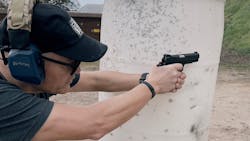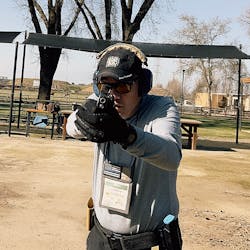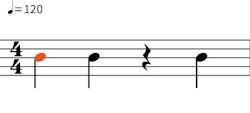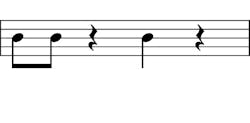Shooting Rhythm: How Shooters Overcome a Training Plateau
Every shooter does it. Once a shooter hits the intermediate stage, they establish regular shooting habits. One habit a shooter keeps most of their career is cadence. Cadence is the rhythmic flow of a sound or activity. For defensive shooting, controlling and training shooting cadence can improve survivability.
When a shooter begins to learn to shoot, they first accomplish the fundamentals. They learn to understand the stable shooting platform. Eventually, most shooters will reach a training plateau, a level where it appears that their skills neither improve or diminish.
It probably doesn’t surprise anyone that many officers will go their entire career at this training plateau, which isn’t necessarily a bad thing. Many trainers will tell you that the training plateau at which officers reside is sufficient for their career. There is, however, a component that can be changed. One can practice changing shooting cadence.The Farnsworth Method
Back when I was trying to learn Morse code, I listened to recorded tutorials, and tapped out code using a key and a trainer, which generated a beeping tone when the circuit was completed. For training in Morse code, there is a standard method, where the length of the “dit” and “dah” (dots and dashes) tones are evenly spaced. That is, as the speed of the code gets faster, the transmitted tones, and their accompanying “rests” in between, get shorter.
It was discovered that, at slower code speeds, a person can learn code by picturing the code chart in their heads, and accessing their memory. A ham operator named Donald Farnsworth (W6TTB) invented a method to overcome the 7 WPM (words per minute) ceiling.
Back in the day, in order to graduate to a higher licensing level as a ham radio operator, one had to pass Morse code tests at 5WPM for one level and 13WPM for another. The different levels opened more frequency access for the user.
The Farnsworth Method requires the learner to pick their desired speed. The characters are transmitted at that speed, and the interval between the characters are trained at a slower speed, until the learner advances. For example, when I wanted to pass the 7 WPM test, I listened to recordings that sent characters (and eventually words) at 13 WPM, with the spaces in between at 7 WPM.
Eventually, I passed the 20 WPM test. I can’t do 20 WPM now, which is also a lesson in perishable skills.
I have a friend who would regularly converse at 64 WPM using just an automatic keyer and his ears. He used the same training method as shooters who, like professional shooter Max Michel, can fire as quickly as a jackhammer.Applying the Farnsworth Method
If a shooter wishes to learn to shoot faster, one method is to deliver a group on target quickly, pause, then continue with the next group. Changing the spacing between groups will speed up the overall shooting.
Since we are going with a controlled pair, stick with two shots per engagement. Use the pause between the shots to assess the target, and line up the next shot. In an actual encounter, this is, “Is the target still a threat?" Down the road, integrate moving into assessment time.From 5 yards, fire the controlled pair, pause, and fire again. I have provided a musical score in the images to communicate the rhythm for shooting this drill.
The controlled pair
Doubletap is the term for quickly delivering two shots at the same target, using the same sight picture. It is similar to the concept of the controlled pair, where two rapid shots are fired, except the sight picture is required for the latter. Regardless of the technique, logic tells us that two rounds will likely improve the probability of stopping the threat, or overcoming the ballistic deficiencies of the cartridge.
I used to train doubletap shooting quite a bit. At pistol distances, it has been my experience that firing two shots quickly will often result in bullet holes close together. That is, doubletap shooting is very effective, even with a carbine. However, I do not recommend the doubletap in Law Enforcement. The ability to shoot two quick shots is something that can be easily learned, but it should be aimed fire when practically possible.
The popularity of steel plate shooting waxes and wanes, but shooting a plate rack is a good skill developer. Some of the professional shooters I have met will tell you that rapid shooting can help a shooter transition from one target to another. I once was around when Rob Leatham, one of my favorite shooting sports athletes, talked about how the recoil of a shot can actually aid the shooter to transition to the next target.
When we do these drills, concentrate on accurate fire and smooth operation. Speed will come with training. I use a RangeTech Shot Timer, which has a training advantage: The shooting coach can control it with a cell phone, and the timer can stay on the shooter’s belt, where it can be heard.
Failure Drill
Logically, the closer one is to the target, the faster a person can engage a target. I recommend starting at 5 yards, a distance from which most shooters can engage quickly without missing. Shooting at different distances is the other reason why we teach controlled pair shooting.
This drill requires a shooter and a coach. The shooter fires controlled pairs at the center mass of the target. They continue firing in this manner until the coach either indicates the threat has been stopped or the current efforts to stop the threat are unsuccessful. In the case of failure, the shooter has to go for a headshot.
The three commands for this this drill are:
- “Threat” Command to engage center mass (The “A” zone, or smallest concentric ring of a combat style target)
- “Failure” Command to engage head shot
- “Cease fire” Command to cease training (Stop shooting or no longer a threat)
The coach initiates the training by calling “Threat”. The shooter begins firing controlled pairs. The coach calls “Failure” randomly, and the shooter has to line up a head shot. Once the headshot is delivered successfully, the drill is over.
As we increase the cadence speed of the double tap, we learn the concept of acceptable sight picture. This is when the sights are quickly aligned, but the acceptable level of precision is only that which gets the bullet within the A zone. The bullet holes don’t need to be touching, it just needs to be an effective hit. As the shooter fires, he should listen to the cadence of the sound, and increase this incrementally as the training progresses. The idea is to continue to deliver effective shots, and never increase the speed past that point.
The headshot takes longer to line up, and therefore there will be a delay in the cadence during the failure drill. As the training progresses, incorporate movement while shooting.
At 10 yards, the margin for error for an acceptable sight picture is reduced, and the goal is to work up to the same cadence as the 5 yard shot.
For all of this training, including the headshot, a miss is considered unacceptable. When the shooter misses, restart using a slower cadence.
Subcaliber Training
My favorite type of training is “trigger time”, where I actually shoot bullets downrange. For this drill, I expend a lot of cartridges. There are effective ways to reduce the use of cartridges. Foremost is subcaliber training.
Glock 19 users can get a Glock 44, which is a 22LR version. Again, this is one of those replicas that is just fun to shoot, but with a serious training value.
For SIG P320 users, Sig Sauer makes a P322, which is a 22LR version. The manual of arms and dimensions mimic a P320 close enough, and it is an incredibly entertaining pistol. SIG also has several BB, pellet, and airsoft replicas. Some of these models fit the same holsters, and were designed for specific training tasks. For example, I have a P365 BB gun, which is almost exactly like the real thing. I have used it to safely train for appendix carry, and I recommend this inexpensive product for anyone with a P365.
In fact, Sig Sauer makes some of the finest training tools in the industry. My P365 BB gun has the CO2 cartridges in the magazines. These magazines have valves that seal them when the magazine is dropped, and they contain the BBs. Operation is completely identical to the real thing. When someone asks me to run them through some training drills, I break out the P365 Air Pistol. It allows realistic training, without training scars, while the shooter/coach can maintain a conversation.
Shooting Rhythm is one way that shooters can overcome a training plateau, and training using rhythm can make all of us better shooters.
About the Author

Officer Lindsey Bertomen (ret.), Contributing Editor
Lindsey Bertomen is a retired police officer and retired military small arms trainer. He teaches criminal justice at Hartnell College in Salinas, California, where serves as a POST administrator and firearms instructor. He also teaches civilian firearms classes, enjoys fly fishing, martial arts, and mountain biking. His articles have appeared in print and online for over two decades.



